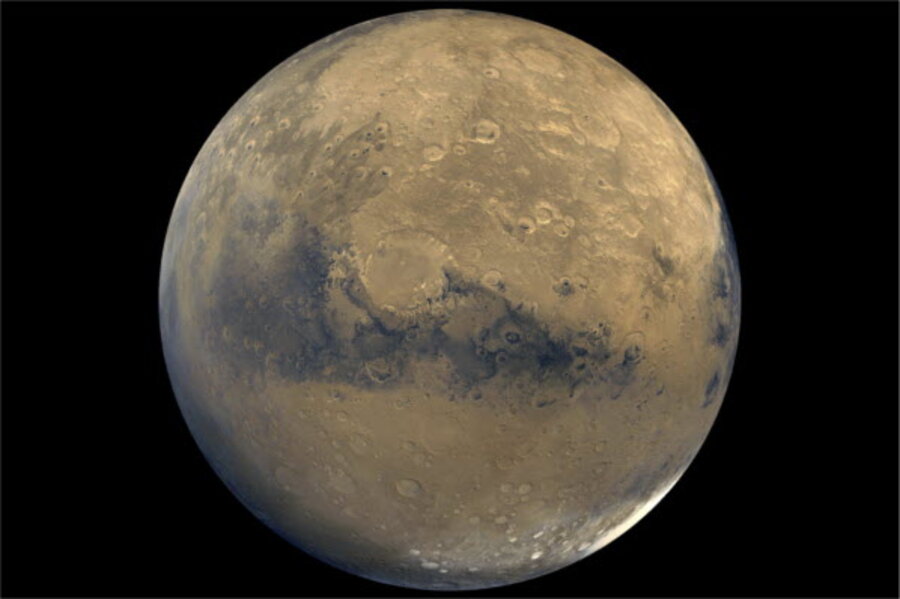Supervolcanoes on Mars? Researchers say they found calderas.
Loading...
Supervolcanoes more powerful than any on Earth appear to have erupted across the surface of Mars early in its history, according to a new study.
The study's authors write that the discovery "fundamentally changes the picture of ancient volcanism and climate evolution on Mars."
The Earth's surface is replete with examples of ancient supervolcanoes, which by definition are capable of blasting more than 240 cubic miles of rock, dust, and magma into the sky and across the landscape. California's Long Valley Caldera, on the back side of the Sierra Nevada, and the Yellowstone Caldera at Yellowstone National Park are but two examples.
Over the decades that robotic spacecraft have visited the red planet, geologists have found evidence for large-scale lava flows from effusive eruptions, where thick gooey magma oozes out of craters and flows across the surrounding terrain.
Researchers also have found shield volcanoes, which can build to enormous heights through repeated eruptions of a more free-flowing form of magma. Mauna Loa is the largest shield volcano on Earth, rising just over 30,000 feet from its undersea base to its above-sea-level summit. Mars boasts the solar system's largest shield volcano, Olympus Mons, which vaults nearly 69,000 feet from its base – a base wide enough to cover most of France.
On Mars, however, evidence for supervolcanoes, which can alter climate as well as the landscape, has been missing.
Or maybe the evidence has just been misinterpreted, say researchers Joseph Michalski of the Planetary Science Institute in Tucson and Jacob Bleacher from NASA's Goddard Space Flight Center in Greenbelt, Md.
Exhibit A: a collection of what the pair interpret as calderas in Arabia Terras, a transition region between Mars’ southern highlands and northern lowlands.
Until now, the features that the duo analyzed were largely thought to be ancient impact craters that had long since filled in with sediment or were depressions that formed when ices beneath the surface melted and flowed away, causing the floor of the formations to slump.
The two researchers zeroed in on two in particular, Eden patera and Euphrates patera. Eden is a depression some 34 miles wide in one direction, 53 miles in the other, and about 1 mile deep at its deepest point.
Unlike impact craters, the researchers note, the suspected calderas have no elevated rims, central peaks on the crater floor, or noticeable rays of ejected material radiating out from the crater. Nor is there any surface evidence of sudden flows of water in the region to suggest ice melt.
Instead, the calderas appear in a patch of ancient crust surfaced with rock already known to have originated in volcanoes. The depressions are far larger than any known to have formed from melting deposits of underground ice. Perhaps more telling: The calderas display internal terraces, much like the interior of the far smaller Kilauea volcano on the big island of Hawai'i.
Such terraces speak to multiple slumping events, in which magma rises and forms a crust, only to slump again between eruptions, perhaps emerging after the blast that formed the caldera in the first place. Eden patera also hosts a cone roughly 2,300 feet tall, which the team posits could be a relic volcanic vent.
The team also notes that arrays of faults in and around the calderas are consistent with an interior collapse point to a previously undiscovered set of supervolcanoes. They estimate that these calderas formed between 3.8 billion and 3.5 billion years ago, as the planet was shifting climatically from warm and wet to colder, drier conditions.
If these did erupt as large explosions, that could help explain geological features researchers have seen throughout Mars' equatorial regions and at the landing sites for NASA's rovers Curiosity and Opportunity.
The stratified look of land forms in these regions is consistent with the result of successive large eruptions laying down layers of fine-grained material. Moreover, analysis from orbit has found high levels of sulphates in the layers, pointing to a volcanic origin, the researchers say.
If the duo's analysis is correct, they suggest that Arabia Terras represents a new region of major volcanic activity early in Mars' history – one that "fills a void in a large fraction of the surface where volcanoes are expected to have occurred but have never been recognized," they write.








